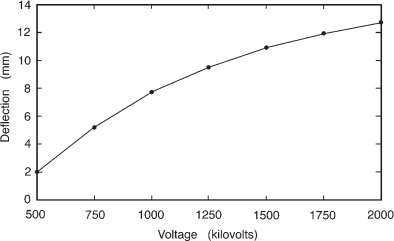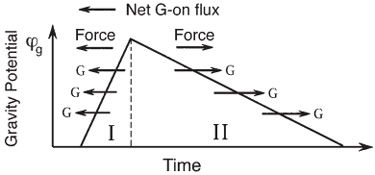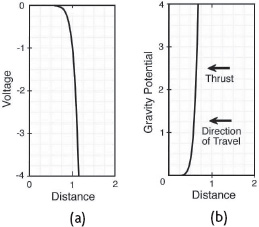Secrets of Antigravity Propulsion (23 page)

Experiments conducted with smoke indicate that the air in the path of the gravity beam would briefly move forward and back with the passage of each emitted gravity impulse.
Firing the gravity impulses through pressure-sensitive carbon paper at varying distances consistently produced a 10-centimeter-diameter black circle.
This indicates that the beam was able to maintain tight coherence over large distances, with the force of the beam cutting off sharply outside of this circular boundary.
In this fashion, this impulse beam is comparable to a laser beam, but achieves its coherence without the help of a resonator cavity.
In an article in
Jane’s Defense Weekly,
Nick Cook reported that a laboratory installation in Russia had demonstrated that, when fitted with a laser sight, this beam was able to knock over a set of books one kilometer away and that it exhibited negligible power loss even at a distance of two hundred kilometers.
11,
12,
13

Figure 6.5.
Graph of the pendulum deflection produced at various electron
beam discharge voltages in the Podkletnov-Modanese gravity beam experiment.
(After Podkletnov and Modanese, 2001)
According to Cook, engineers at the Boeing Aerospace Corporation Phantom Works facility in Seattle were actively interested in investigating this beam technology with the aim of developing it into an R&D project.
An internal company briefing document written entitled “Gravity Research for Advanced Space Propulsion” states, “If gravity modification is real, it will alter the entire aerospace business.”
14
Other aerospace companies interested in Podkletnov’s beam generator included BAE Systems and Lockheed Martin.
Cook reported, however, that the Russian government had resisted allowing the gravity beam technology to be exported.
Subquantum kinetics predicts that Podkletnov’s gravity impulse beam generator would produce no recoil when fired.
That is, the back-directed impulse, which is delivered to the superconducting cathode at the time the electron pulse discharges, is canceled out by the equal and opposite forward-directed impulse delivered to the anode when the anode subsequently absorbs the electron discharge.
However, the gravity field pulse, which continues its forward journey through and past the anode, would then produce additional forward thrusts on all masses through which it passed, in apparent violation of Newton’s third law of motion.
In this case, when these remote thrusts are included, it is no longer true that every action necessarily produces an equal and opposite reaction.
In 2003 I wrote to Dr.
Podkletnov indicating to him my belief that his impulse generator should produce no recoil when it is operating and also that, based on subquantum kinetics, I expected that his pulses would propagate at superluminal speeds.
15
He wrote back that I was correct that, in fact, the device produces “no back mechanical reaction” when fired and also that his team had found that the pulses traveled superluminally.
He said that they were able to determine that the pulses traveled at close to sixty-three to sixty-four times the speed of light, a result that they planned to check and recheck before submitting it for publication.
He also wrote, “It is amazing that you could predict the effects that we have observed.
We will be happy to learn more about your subquantum kinetics approach.”
16
I subsequently sent him a copy of my book
Subquantum Kinetics
, and in 2004 he published a very favorable review about it in
Infinite Energy
magazine.
17
In their 2003 paper, Podkletnov and Modanese acknowledge that conventional theories of gravity fail to explain the action of their gravity impulse beam.
For example, general relativity predicts that gravity waves should induce quadrupolar forces in a target mass that are oriented transverse to the direction of wave travel.
Instead, the gravity impulse beam is observed to produce repulsive longitudinally directed gravitational forces, hence, in line with the direction of wave propagation.
This is just as Tesla had observed for his shock discharges.
It also confirms a key prediction of subquantum kinetics that electrons would produce matter-repelling gravity potential hills (G-etheron hills) and that a change in the electric or gravity potential field should propagate forward as a longitudinal potential wave.
18,
19
Subquantum kinetics offers the following explanation of how these gravity waves might be generated: A shock discharge from a cathode to an anode would produce a wave having a sharp rise in electric field potential, followed by a more gradual relaxation.
As described in chapter 4, section 4.1, subquantum kinetics predicts that an electron should generate a gravity potential hill.
An electron discharge, then, would be accompanied by an in-phase gravity potential wave.
This would appear similar to that shown in figure 6.6, in which the wave is shown traveling from right to left.
The front of this wave would consist of a sharp rise in G-on concentration, that is, a rise in gravity potential.
Its gradient would induce a gravitational force on encountered masses in its forward direction of travel, shown as from right to left in the figure.
Hence, it would have a repulsive effect.
The trailing part of the wave, which would have a declining gravity potential, would induce an opposing thrust that would create an attractive force on encountered masses.
This drawing is highly idealized, since a pulse discharge typically produces an oscillating decline in voltage as it tails off.
A force (
F
) applied to an object over a period of time (t) yields a quantity called impulse, the product of force and time (
I
=
F
×
t
), which equals the resulting change in the object’s momentum.
So if a forward repulsive force exerted during the passage of the leading edge of the wave were to be ten times as great as the reverse attractive force exerted during the passage of its trailing edge but were to last only one-tenth as long as the force exerted during the passage of the trailing edge, the forward impulse would exactly equal the reverse impulse.
So the wave’s passage would have no net effect on the momentum of the target mass.
Consequently, to explain the findings of Podkletnov and Modanese, another important factor must be involved—virtual charge.
The advancing electron discharge would be accompanied by a negative electric potential wave, and not only would the front of this wave have a very steep drop in voltage with distance, but also its voltage would change with distance in a highly nonlinear manner.
*18
So this shock front would be associated with the creation of a very high negative virtual charge density that would produce an enormous matter-repelling gravity field.

Figure 6.6.
A propagating electrogravitic shock wave capable of producing a repulsive gravitational force.
The wave would be traveling from right to left, and the net gravitational force and G-on flux would also be directed from right to left.
(P.
LaViolette, © 2007)
This sudden drop in voltage may be modeled with the exponential equation V = –r
10
, which is plotted in figure 6.7a.
Relation 7, from chapter 4, predicts that this should produce a gravity potential field varying as φ
g
(r)
∝
∇
2
φ
E
(r), hence as φ
g
∝
r
8
.
This exceedingly steep gravity potential profile is plotted in figure 6.7b.
The wave is plotted in the figure as traveling to the left, and its gravity gradient would be producing a force depicted as directed to the left, hence it would be repulsive.
The damped sine wave oscillation that trails the shock front would produce a gravitational thrust that was many orders of magnitude smaller and oscillating from a reverse to a forward direction.
However, the forward thrusts would always dominate, resulting in a net repulsive thrust.
When the electron discharge is absorbed in the impulse generator’s anode, the electric field potential of the discharge goes to zero.
Nevertheless, the gravity wave that was generated while the discharge was in flight continues to move forward.
It passes through the anode and ultimately produces thrust effects on distant masses.
The steep gravity potential gradient at the shock’s leading edge would induce a convective G-on flux in the direction of wave propagation, or, in other words, would create a G-on ether wind.
The G-on fluxes described here would be accompanied by X-on fluxes traveling in the same direction (and by Y-on fluxes traveling in the opposite direction).
In effect, with each firing of the gravity impulse beam, a puff of G-ons would travel rectilinearly away from the cathode.
We may compare this to the firing of a cannon, in which the outward flight of the cannonball is accompanied by a forward-moving slug of air that creates a collimated ring vortex, or smoke ring.
In a similar fashion, this G-on puff would be accompanied by an outward-moving G-on ring vortex that may help to collimate the impulse.

Figure 6.7.
(a) Voltage at the front of the electron shock discharge plotted as a function of time or distance.
The wave travels to the left.
(b) Corresponding gravity potential profile arising from the virtual charge density the wave would generate.
(P.
LaViolette, © 2007)
Podkletnov’s gravity beam generator does not generate gravity impulses specifically because its cathode emitter is made of superconducting material.
Rather, the gravitational repulsion effect of its shocks may be attributed to the electrogravitic coupling that exists between charge and gravity.
The subquantum kinetics explanation given above for the production of the gravity impulse effect would apply equally well to the repulsion thrusts produced by Tesla’s shock discharge pulses.
The superconductivity of Podkletnov’s cathode emitter more likely contributes to boosting the pulse’s imparted force by sharpening and steepening its leading-edge field gradient.
Also, it may help to cohere the gravity wave into a nondiverging beam.
